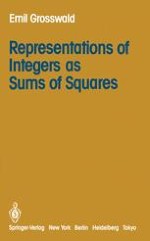During the academic year 1980-1981 I was teaching at the Technion-the Israeli Institute of Technology-in Haifa. The audience was small, but con sisted of particularly gifted and eager listeners; unfortunately, their back ground varied widely. What could one offer such an audience, so as to do justice to all of them? I decided to discuss representations of natural integers as sums of squares, starting on the most elementary level, but with the inten tion of pushing ahead as far as possible in some of the different directions that offered themselves (quadratic forms, theory of genera, generalizations and modern developments, etc.), according to the interests of the audience. A few weeks after the start of the academic year I received a letter from Professor Gian-Carlo Rota, with the suggestion that I submit a manuscript for the Encyclopedia of Mathematical Sciences under his editorship. I answered that I did not have a ready manuscript to offer, but that I could use my notes on representations of integers by sums of squares as the basis for one. Indeed, about that time I had already started thinking about the possibility of such a book and had, in fact, quite precise ideas about the kind of book I wanted it to be.
